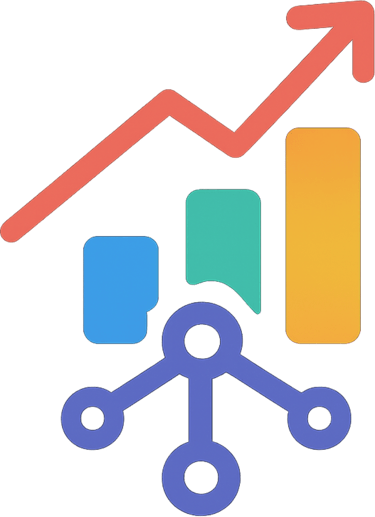AI in Finance: Transforming Banking Operations
Discover how AI in finance is transforming banking operations and explore various AI use cases in financial services. Ideal for entrepreneurs, professionals, and nonprofits seeking proven ROI.
Rudra Prakash Parida
11/26/202516 min read


Introduction: The Financial Services AI Revolution Is Now
Financial services are experiencing a fundamental transformation. AI in finance is no longer a competitive differentiator, it's rapidly becoming a baseline requirement. Yet the conversation around financial services AI often overlooks a critical reality: entrepreneurs juggling bootstrapped operations need different solutions than financial professionals navigating regulatory complexity or nonprofit leaders stretching limited budgets.
The momentum is undeniable. 78% of organisations now use AI in at least one business function up from just 55% one year earlier. In UK financial institutions specifically, the adoption surge is even sharper: 59% now report improved productivity from AI adoption, nearly double the 32% reported in 2024. For nonprofits and small businesses, the picture is equally compelling: organisations adopting AI for banking and financial automation report significant efficiency gains, cost reductions, and improved decision-making.
Yet a critical gap persists. Only 29% of financial institutions report that AI use cases in financial services have delivered meaningful cost savings, and 65% experience implementation delays averaging 14 months. The challenge isn't technology availability, it's strategic focus. Knowing which AI applications deliver ROI within your specific constraints separates successful implementations from costly experiments.
This comprehensive guide addresses three audiences navigating this transformation: entrepreneurs building scalable models with lean teams, financial professionals managing operational complexity and compliance demands, and nonprofit leaders maximizing mission impact with constrained resources. We'll explore proven AI in banking applications, real-world examples, implementation strategies, and practical next steps tailored to each audience's unique needs.
Understanding AI in Finance: The 2025 Landscape
Financial services AI encompasses machine learning, natural language processing, predictive analytics, and automation technologies applied across banking, wealth management, lending, compliance, and financial advisory. The global AI in finance market is projected to surge from £28.93 billion in 2024 to £143.56 billion by 2030 at a compound annual growth rate of 30.6%.
Investment trajectory reveals the stakes. The financial services industry invested approximately $35 billion in AI in 2023, with banking accounting for roughly $21 billion of that investment. This capital deployment reflects proven returns: AI-driven financial services AI contributes an estimated $2 trillion to the global economy through innovative strategies, superior customer insights, and operational efficiency gains.
The shift from experimentation to execution is accelerating rapidly. 91% of UK financial institutions now view AI as an opportunity rather than a threat up from 80% just one year prior. Over half of these institutions plan to increase AI for banking investment over the next 12 months. At Lloyds Banking Group alone, over 800 AI models now operate in production, representing more than 200 distinct AI use cases in financial services designed to enhance colleague and customer experience simultaneously.
For entrepreneurs, financial professionals, and nonprofit leaders, this environment creates unprecedented opportunity but only with strategic prioritization of high-impact applications aligned with organizational capabilities and constraints.
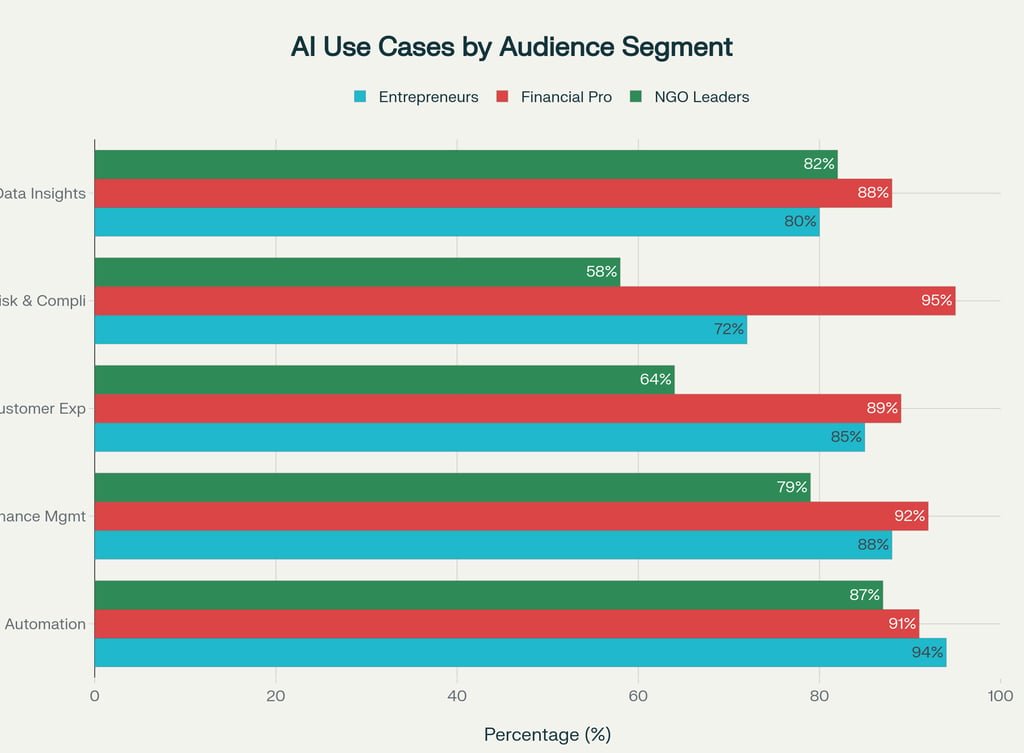

Section 1: AI-Powered Automation Transforming Operations
For Entrepreneurs: Achieve Enterprise-Scale Output With Lean Teams
Entrepreneurs operate under perpetual constraints: limited capital, small teams, and relentless time pressure. AI automation for small businesses delivers powerful solutions through intelligent automation that eliminates repetitive tasks, enabling small teams to achieve output previously requiring significantly larger headcount.
The adoption trajectory among SMEs is striking: AI adoption in small firms grew by 72% between 2023 and 2024 across OECD countries, with entrepreneurs overwhelmingly prioritising automation and efficiency. Real applications include: marketing content generation at scale, automated invoice processing and expense management & categorisation, social media scheduling optimised by AI-driven timing insights, and customer inquiry handling through chatbots that continuously learn.
Accessible platforms make this transformation realistic for bootstrapped ventures. ChatGPT handles professional content drafting; Zapier connects multiple business systems without custom coding; Ramp automatically categorises expenses and identifies cost-saving opportunities; Hootsuite optimises social media posting schedules based on engagement patterns. The cumulative impact: entrepreneurs redirect hours previously consumed by administrative work toward strategic growth activities, product development, customer acquisition, and business development.
Practical Example:
A UK-based digital marketing agency implemented AI in finance automation for client proposal generation and business process automation reported saving 8–10 hours weekly equivalent to a full-time employee's output redirected toward business development. For lean teams, this efficiency gain represents the difference between stagnation and accelerated growth.
For Financial Professionals: Transform Back-Office Operations Into Strategic Assets
Financial professionals face unrelenting operational pressure: regulatory compliance deadlines, transaction monitoring requirements, audit trail maintenance, and manual reconciliation consume enormous institutional resources. AI for banking transforms these workflows through intelligent compliance automation that maintains accuracy while accelerating execution dramatically.
JP Morgan Chase's COiN (Contract Intelligence) platform demonstrates this at enterprise scale. The system automates commercial loan agreement review, work historically requiring junior lawyers and paralegals and has reportedly saved over 360,000 hours of manual document processing annually. For compliance teams, AI use cases in financial services like real-time transaction monitoring, scanning communications and transactions for regulatory violations, reducing manual review time by 30% or more while improving detection accuracy through RegTech solutions.
The productivity gains are measurable sector-wide: 59% of UK financial institutions now report improved productivity from AI adoption nearly double the 32% reported one year earlier. Additionally, 33% report enhancing client experience through AI, and 33% are gaining deeper customer insights informing strategic decisions. These represent operational transformation already underway across the sector.
Practical Example:
A mid-sized financial advisory firm implementing AI-powered document processing reduced client onboarding from 5 business days to 48 hours, improving client satisfaction while freeing compliance staff for strategic risk assessment. The reallocation of human expertise from manual data entry to judgment-intensive work creates compound competitive advantage over time.
For Nonprofit Leaders: Redirect Administrative Time Toward Mission Impact
Nonprofit teams operate under permanent resource constraints, yet administrative demands never relent. Data entry, donor database maintenance, volunteer scheduling, grant report preparation, and financial reconciliation consume hours that should fuel program delivery and community engagement. AI in finance offers nonprofits a critical solution: Nonprofit automation that maintains operational integrity while redirecting team energy toward mission work.
The transformation is tangible: instead of nonprofit administrators spending 6 hours weekly updating spreadsheets and cleaning donor records, AI-powered CRM systems maintain data accuracy automatically while flagging high-value donors, lapsed supporters, and at-risk relationships requiring attention. Automated workflows trigger personalised thank-you emails for major donations, send engagement reminders based on donor behavior patterns, and generate impact story summaries requiring only final human review before deployment.
Beyond donor management, AI for banking principles streamline nonprofit financial operations: automated expense categorisation ensures grant compliance, predictive cash flow models forecast funding gaps before they become crises, and program cost analytics identify which initiatives deliver highest mission ROI per dollar invested. This intelligence transforms nonprofit financial management from reactive (responding to immediate demands) to proactive (anticipating needs and allocating resources strategically).
Practical Example:
A mid-sized women's empowerment nonprofit serving ages 13–25 automated donor acknowledgment letters, volunteer scheduling, and program reporting. Result: 12 hours per week redirected from administrative work to program expansion and direct donor relationship cultivation. For organizations where every hour translates directly to community impact, this efficiency gain is transformational.
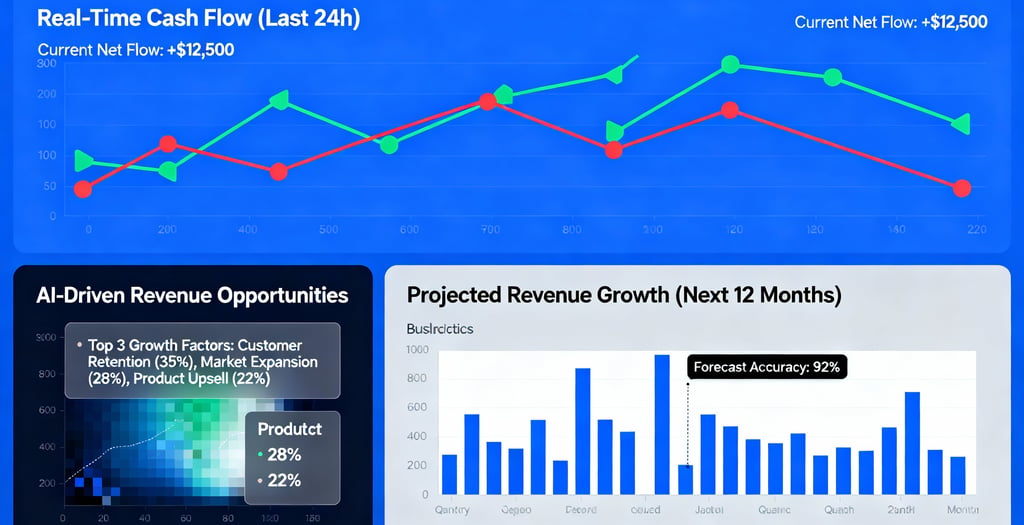

Section 2: AI in Finance Powering Strategic Decision-Making
For Entrepreneurs: Transform Transaction Data Into Strategic Clarity
Cash flow forecasting represents one of the most pressing challenges for growing businesses. Without clear visibility into money flowing in and out, entrepreneurs can't make confident decisions about hiring timing, investment allocation, or pricing strategy. Financial services AI addresses this directly: AI-powered financial forecasting translates raw transaction data into predictive insights entrepreneurs can act on immediately.
Modern fintech tools like Trovata and Tesorio automatically aggregate financial data from multiple bank accounts and institutions, analyse spending patterns against historical trends, and project future cash positions with remarkable accuracy. This intelligence enables precise strategic decisions: entrepreneurs forecast exactly when to invest in marketing, when hiring is financially sustainable, and whether upcoming expenses pose liquidity risk requiring proactive management.
Expense management platforms add another efficiency layer. Ramp's AI categorises business expenses automatically, identifies cost-saving opportunities through spending pattern analysis, and generates compliance-ready financial reports without manual spreadsheet work. For startups and early-stage companies operating on tight margins, these capabilities represent the difference between runway extension and financial crisis.
Adoption Trend:
Between 2023 and 2024, AI adoption among SMEs grew by 72% across OECD countries, with financial management applications ranking among the highest-priority use cases. Small business leaders using AI in finance report measurably positive business impact, with 85% seeing increases in efficiency and productivity.
Practical Example:
A growth-stage SaaS startup using AI use cases in financial services for cash flow forecasting reduced financial close time from 10 days to 2 days while identifying $120K in annual expense savings through automated spending pattern analysis. The time savings alone justify adoption; the strategic insight compounds value significantly.
For Financial Professionals: Enable Sophisticated Decision Support at Scale
Financial advisory, wealth management, and investment decision-making have historically relied on professional experience combined with manual financial analysis, a time-intensive process limiting the volume of clients professionals can serve effectively. AI in finance transforms this dynamic: AI-powered analytics surface patterns across massive datasets that human analysts would miss.
Algorithmic trading platforms use machine learning to identify market opportunities and optimize portfolio rebalancing continuously, adapting to changing conditions faster than traditional approaches. For wealth advisors, AI for banking tools analyse client behavior, assess risk tolerance dynamically, and recommend portfolio adjustments personalised to individual circumstances delivering hyper-personalization previously reserved for ultra-high-net-worth clientele to clients across all asset tiers.
Credit decisioning represents another high-impact AI use case in financial services. Financial services AI enables institutions to assess borrower creditworthiness using alternative data sources transaction history, utility payment patterns, employment stability signals expanding credit access to underserved populations while maintaining rigorous credit risk standards.
Sector-Wide Impact:
58% of financial institutions directly attribute revenue growth to AI primarily through enhanced trading performance, predictive risk management, and operational process automation. Institutions adopting AI in finance with specialist teams see up to 60% efficiency gains and 40% cost reductions in areas such as onboarding, compliance, and settlement.
Practical Example:
A mid-market wealth advisory firm implementing AI for banking portfolio management tools improved client satisfaction scores by 18% while reducing manual rebalancing work by 40%, enabling advisors to expand client capacity without sacrificing service quality.
For Nonprofit Leaders: Forecast Funding and Predict Program Outcomes
Nonprofits operate with perpetual information gaps: Will donors maintain giving levels next year? Which program initiatives generate the highest community impact per dollar invested? Which demographic groups remain underserved? AI in finance answers these critical strategic questions by analyzing historical data to forecast future patterns with actionable precision.
Machine learning models trained on past fundraising campaigns identify which outreach strategies, messaging approaches, timing, and donor segments generate highest conversion rates and lifetime value. AI use cases in financial services like predictive donor models flag high-capacity prospects for cultivation, identify at-risk donors requiring relationship renewal, and segment supporters based on behavior enabling personalized engagement that measurably increases retention.
Beyond fundraising, program analytics leverage financial services AI principles to identify which services reach highest-need populations, predict seasonal demand fluctuations requiring resource preparation, and flag emerging community trends requiring strategic reallocation. Financial forecasting specifically tailored for nonprofits addresses cash flow volatility inherent to grant-dependent funding: AI for banking tools analyze grant disbursement patterns and predict cash position months in advance.
Practical Example:
A youth empowerment nonprofit using AI in finance predictive analytics increased major donor retention by 22% and identified 15 high-capacity prospects previously invisible in manual analysis. The revenue impact estimated at $180K additional annual funding—directly translated to expanded program capacity serving 40+ additional young women annually.


Section 3: Customer Experience and Relationship Intelligence
For Entrepreneurs: Deliver Personalised Service at Enterprise Scale
Customer support at scale typically forces entrepreneurs to choose: either hire large support teams (financially unsustainable) or accept slow, impersonal service that damages retention. AI in finance solves this dilemma through intelligent chatbots and virtual assistants handling routine inquiries 24/7 while escalating complex issues to humans creating efficient triage that accelerates resolution.
Platforms like Freshchat, Kustomer, and HappyFox deploy AI-powered chatbots that continuously learn from every interaction, improving accuracy without additional programming. For entrepreneurs, operational benefits are immediate: customer inquiries answered instantly regardless of time zone, support staff freed from repetitive questions to focus on complex problem-solving, and customer satisfaction maintained despite lean teams.
Beyond support, AI for banking principles enables smart personalisation at scale. Recommendation engines analyse customer engagement and transaction history to suggest products tailored to individual preferences. An e-commerce entrepreneur using AI use cases in financial services for product recommendations increases average order value by 15–25% through precision matching sophistication traditionally requiring large marketing teams.
Adoption Impact:
Entrepreneurs implementing AI in finance customer service chatbot automation report response time reductions from hours to minutes, customer satisfaction improvements of 20%+, and support staff time savings of 10–15 hours weekly redirected toward growth.
Practical Example:
A UK-based digital marketing agency using AI chatbots for client onboarding reduced inquiry response time from 8 hours to 5 minutes and increased client satisfaction by 23%, while cutting support staff hours by 12 weekly time redirected toward strategic account management.
For Financial Professionals: Deliver Hyper-Personalization Across Thousands
Modern banking customers expect financial services tailored to their circumstances: investment advice matching risk tolerance, product recommendations based on current position and goals, and communication personalised to preferences. Financial services AI enables sophisticated personalization across thousands of customers simultaneously impossible through traditional advisory models.
Bank of America's Erica AI assistant exemplifies this transformation. Since launch, the virtual assistant has facilitated over 1 billion interactions, helping customers manage accounts, track spending, receive personalized financial advice, and adjust behaviors aligned with financial goals. The platform learns individual preferences and adapts recommendations, creating personalized experience impossible through traditional channels.
For financial institutions, AI in finance translates to competitive advantage: customers receiving personalized guidance show higher engagement, longer retention, and greater lifetime value. AI for banking also identifies which customers benefit from specific products investment options, insurance coverage, lending products enabling targeted cross-selling with dramatically improved conversion rates.
Sector Impact:
33% of UK financial institutions report that AI enhances client experience; 33% report gaining deeper customer insights informing strategic decisions. Institutions deploying AI use cases in financial services for customer personalization see measurable improvements across satisfaction, retention, and revenue metrics.
Practical Example:
A mid-sized UK financial services firm implementing AI in finance personalization increased customer lifetime value by 31% and reduced churn by 15% within 12 months.
For Nonprofit Leaders: Deepen Donor Relationships at Scale
Donors increasingly expect recognition and communication tailored to their interests and giving history. Yet nonprofits with limited staff struggle to provide this personalization at scale. AI in finance enables hyper-personalized donor engagement without proportionally increasing workload.
AI-powered donation forms dynamically adjust suggested amounts based on real-time donor data and giving history, increasing per-session fundraising by 12% compared to static forms. Segmentation tools identify donors by behavior and interests recent supporters, major donors, at-risk lapsed donors, first-time givers enabling targeted communication strategies for each group.
Automated thank-you workflows trigger personalised messages acknowledging specific gifts, explaining impact, and maintaining relationships between formal interactions. AI use cases in financial services include sentiment analysis tools that scan donor communications, flagging when a supporter may be disengaged or dissatisfied, enabling proactive relationship renewal before loss.
Practical Example:
A nonprofit focused on women's empowerment using AI for banking donor segmentation and personalized communication increased donor retention by 18% and average gift size by 14%, generating $180K additional annual revenue with zero additional fundraising staff.
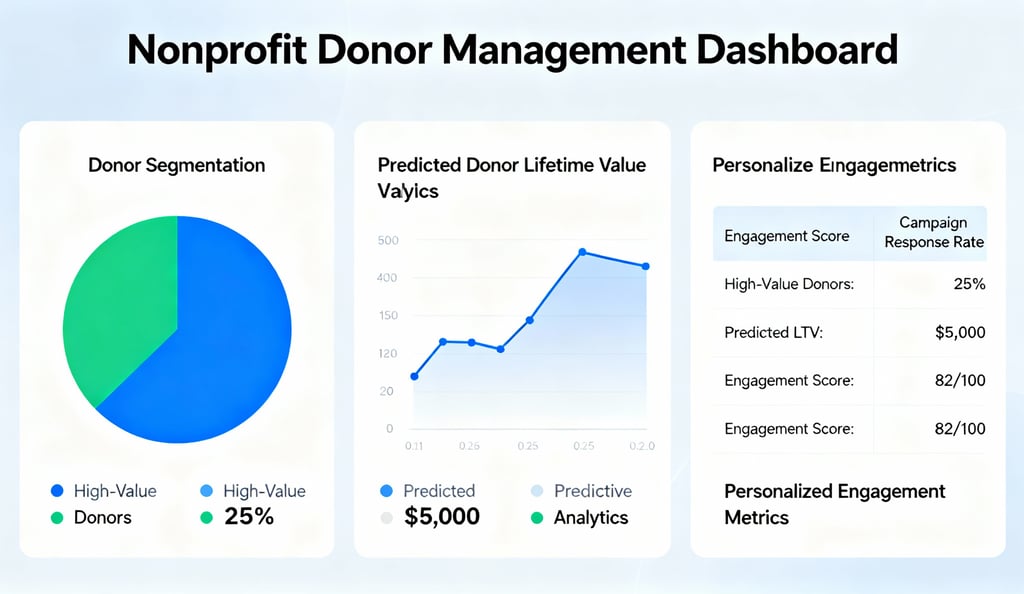

Section 4: Risk Management, Compliance, and Security
For Entrepreneurs: Protect Growth With Intelligent Fraud Detection
As businesses scale and online transactions increase, fraud risk grows proportionally. Manual fraud detection based on preset rules is reactive and error-prone. Financial services AI protects growth through real-time fraud detection systems that identify sophisticated attacks before they impact business or customers.
Machine learning models analyse thousands of data points across transactions: spending patterns, geographic anomalies, device fingerprints, and behavioral deviations. When patterns deviate from established norms, systems flag for review instantly. The sophistication is crucial: as fraudsters evolve tactics, AI in finance models adapt continuously, learning from new attack patterns.
For payment-heavy businesses (e-commerce, SaaS, marketplaces), this protection is essential to maintaining customer trust and minimising chargebacks. Mastercard's Decision Intelligence platform, used by millions of transactions globally, applies AI scoring in real-time, reducing fraud while maintaining approval rates the balance critical to business operations.
Practical Example:
A UK-based e-commerce platform implementing AI use cases in financial services fraud detection reduced fraudulent transactions by 67% while decreasing false-positive rates by 60%, maintaining customer satisfaction and reducing chargeback costs by £145K annually.
For Financial Professionals: Navigate Compliance With Precision
Regulatory compliance demands are relentless: anti-money laundering (AML) requirements, know-your-customer (KYC) obligations, transaction monitoring, and documentation standards consume enormous resources. AI for banking automates compliance workflows, applying consistent standards while detecting edge cases requiring human judgment.
RegTech platforms scan communications, transactions, and documents for compliance violations automatically. They flag suspicious patterns, generate audit trails, and maintain documentation eliminating manual compliance review while improving accuracy. Compliance teams shift from manual execution toward strategic risk management and emerging threat assessment.
Natural language processing components analyse emails, calls, and messages for compliance violations detecting potential market manipulation, insider trading, or conflicts of interest with precision manual review cannot match.
Practical Example:
A financial services firm implementing AI in finance compliance monitoring reduced manual compliance review time by 35%, improved violation detection accuracy by 42%, and reduced regulatory audit findings by 50%.
For Nonprofit Leaders: Safeguard Donor Data and Trust
Nonprofits handle sensitive donor information: names, contact details, financial contributions, communication preferences. Data breaches destroy donor trust and incur regulatory penalties. AI in finance protects through anomaly detection, access monitoring, and threat identification.
AI compliance tools ensure nonprofits meet data protection regulations (GDPR, CCPA) automatically: they audit data sharing practices, flag non-compliant workflows, and ensure retention policies align with legal requirements. For organizations with lean IT teams, this automated governance is essential.
Practical Example:
A nonprofit running AI use cases in financial services security monitoring prevented a data breach attempt, maintained donor trust, and demonstrated regulatory compliance to major grant funders a competitive advantage in fundraising.
Implementation Strategy: Where and How to Start
For Entrepreneurs: Start Small, Measure, Scale
The temptation to implement AI in finance everywhere is strong. Resist it. Begin with one high-impact, high-frequency problem the task consuming most time or creating most friction. This might be customer support chatbots, content generation, or expense management, depending on your specific bottleneck.
Select tools with clear ROI: if your bottleneck is customer inquiry handling, a chatbot costing £200/month with potential to save 10 weekly support hours yields measurable ROI within weeks. Implement, measure, and expand only after proving value in your context.
Avoid custom AI development initially. Cloud-based SaaS tools (ChatGPT, Hootsuite, Zapier integrations, Ramp, Trovata) offer enterprise-grade capabilities at SME pricing. They require no technical AI expertise and integrate with existing systems rapidly.
Implementation Checklist:
Identify top 3 time-consuming, high-frequency tasks in your operation
Research available AI use cases in financial services solutions with free trials
Implement one tool with clear success metrics (time saved, accuracy improved, revenue impact)
Measure results over 4 weeks
Scale or iterate based on results
For Financial Professionals: Assess Integration and Regulatory Alignment
Financial services operate within strict regulatory constraints. Before implementing any AI for banking tool, ensure it meets compliance requirements: data residency, algorithmic transparency, audit trails, and bias mitigation.
Partner with established RegTech providers who understand financial services compliance deeply. Avoid building custom AI in finance solutions without regulatory expertise; compliance risk exceeds development cost savings.
Prioritise use cases with clear compliance benefits: fraud detection, AML monitoring, KYC automation. These generate regulatory approval alongside operational value.
Implementation Checklist:
Consult compliance and legal teams before tool selection
Select vendors with financial services experience and regulatory certifications
Establish explainability requirements: understand how AI systems reach decisions
Implement with human oversight initially; automate only after validation
Document financial services AI decision-making for audit purposes
For Nonprofit Leaders: Leverage Affordable Cloud Solutions
Nonprofit budgets demand cost-conscious implementation. Thankfully, most accessible AI tools explicitly serve nonprofits with discounted or free access. Platforms like Zapier, ChatGPT, and CRM systems (Zoho, Keela) offer nonprofit pricing tiers.
Start with donor management and fundraising, where AI use cases in financial services impact is highest and tangible: predictive donor models, personalized communication automation, and donation form optimization. These tools generate measurable revenue impact, justifying expansion.
Resist implementing across all operations simultaneously. Phased adoption reduces overwhelm and training burden: implement donor management AI in month 1, program analytics in month 3, compliance automation in month 6.
Implementation Checklist:
Verify nonprofit pricing eligibility for selected AI in finance tools
Start with donor management and fundraising (highest immediate impact)
Allocate 2–3 hours weekly for staff training and adoption
Measure against baseline metrics (fundraising revenue, donor retention, admin hours saved)
Expand to additional use cases only after first implementation stabilises

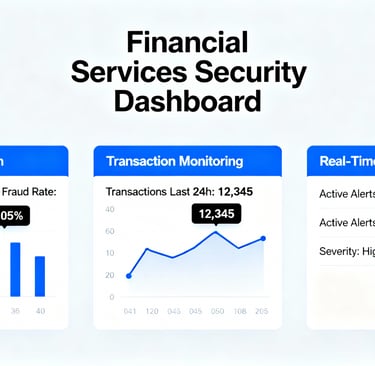
Frequently Asked Questions About AI in Finance
Q1: Which AI use case should my organisation prioritize first?
A: Start with the task consuming the most time or creating the most friction. For entrepreneurs, often customer support or content creation. For financial professionals, compliance or fraud detection. For nonprofits, donor management and fundraising optimization represents the highest immediate impact.
Q2: Is implementing AI in finance expensive?
A: Not necessarily. Cloud-based SaaS tools start at £10–50/month. Enterprise financial services AI solutions cost more but are economical only at significant scale. Start affordable and expand based on proven ROI.
Q3: Will AI for banking replace my team?
A: No. According to recent research, 81% of small business leaders say AI augments not replaces their workforce. AI in finance eliminates repetitive work, freeing humans for strategic, creative, and relationship-building activities where humans excel.
Q4: How do I ensure AI doesn't introduce bias into financial services AI decisions?
A: Choose vendors with bias monitoring and mitigation practices. Start with narrow AI use cases in financial services with high oversight. Continuously monitor outcomes for fairness. Maintain human judgment over AI recommendations, especially for high-impact decisions.
Q5: What if our organization lacks technical expertise for AI in finance?
A: Most accessible AI for banking tools require zero technical expertise they're designed for business users. Start with no-code platforms (Zapier, ChatGPT, SaaS applications). Expand to technical solutions only if justified by scale.
Q6: How do I measure AI implementation ROI?
A: Define metrics before implementation: time saved, accuracy improved, revenue generated, cost reduced, customer satisfaction increased. Measure baseline before financial services AI adoption, then compare after 4–8 weeks. Be specific: measure "hours of support work automated" or "response time reduced" not vague "efficiency gains."
Key Takeaways: Your AI Action Plan
AI adoption is accelerating rapidly: 94% of small business leaders report positive impact; 91% of SMEs using AI gain efficiency; nonprofits reduce admin burden significantly.
Start with your highest-friction problem: Whether it's customer support (entrepreneurs), compliance (financial professionals), or donor management (nonprofits), begin where impact is immediate and measurable.
Cloud-based SaaS solutions are accessible and affordable: You don't need enterprise budgets or technical AI expertise. Start with ChatGPT, Hootsuite, Zapier, Keela, or Ramp all designed for your audience's constraints.
Financial services AI delivers measurable returns: 59% of UK financial institutions report productivity improvements; 58% attribute revenue growth directly to AI adoption; 33% enhance client experience through AI in finance.
Measure everything: Define success metrics upfront. Measure baseline. Implement AI for banking tool. Measure results after 4–8 weeks. Expand only if ROI is clear and aligned with organizational strategy.
AI augments human work; it doesn't replace it: The highest value comes from humans focusing on relationship-building, strategy, and judgment while AI in finance handles routine execution.
Conclusion
The question is no longer whether to adopt AI in finance it's how to start strategically. Entrepreneurs, financial professionals, and nonprofit leaders who begin implementing AI use cases in financial services now will outpace competitors still operating on manual processes.
You don't need massive budgets, extensive technical expertise, or enterprise-level implementation timelines. Begin with one high-impact problem this week: identify the task consuming most time and creating most frustration within your organization. Research two or three AI for banking tools designed for that specific problem. Test one tool with a free trial.
Your next strategic move:
Entrepreneurs: Select one customer service or content creation workflow. Test ChatGPT or a niche AI tool for 7 days. Measure time saved. If positive, implement at scale.
Financial Professionals: Identify your most time-consuming compliance or data-entry task. Research one RegTech solution designed for that workflow. Schedule a 30-minute vendor demo. Assess regulatory alignment and explainability standards.
Nonprofit Leaders: Choose your top fundraising challenge (donor management, personalization, or grant reporting). Test a nonprofit-friendly AI in finance platform with free or low-cost access. Measure impact over 4 weeks against baseline metrics.
Contact
Reach out for insights and support
Phone
+447768010239
© 2025. All rights reserved.
